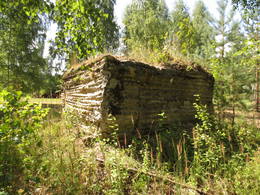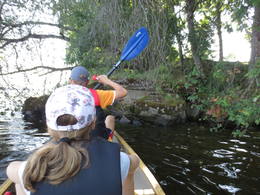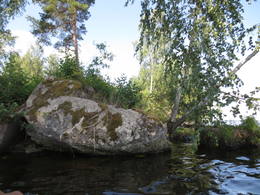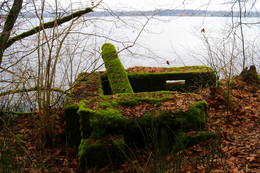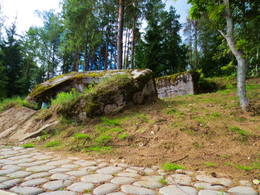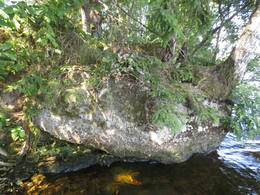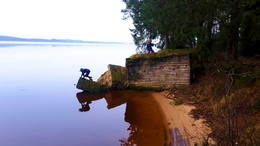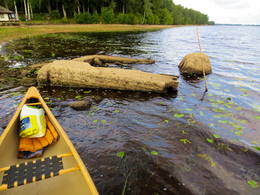Pingutused Ķegumsi hüdroelektrijaama plahvatuse ärahoidmiseks
Teise maailmasõja ajal, kui armeed taandusid, õhiti Lätis suur hulk sõjaliselt ja logistiliselt olulisi objekte, et need ressursid vaenlase kätte ei jääks. Sellised rajatised asusid ka Ķegumsi läheduses, kus üks olulisemaid objekte on Ķegumsi HEJ, mis tänu oma töötajate pingutustele ja pingutustele täielikult ei hävinud.
Ma räägin teile sellest päevast nii, nagu olen kuulnud ja teada saanud Kegumsi ajaloomuuseumi jaoks dokumente kogudes. On mõned teadaolevad faktid, aga on ka palju tundmatuid fakte, mida tõenäoliselt täielikult ei selgitata.
Teades, kuidas sakslased kõik õhku lasevad, oli see perspektiiv selge ka Kegumi elanikele. Veelgi enam, kui Kegumis paiknev valveüksus, Sonderkommando, hakkas silda mineerima, mõtlesid ja tegutsesid Kegumi HPP direktor Pāvels Krasovskis ning ilmselt ka tema kaaslased ja käsilased, kelle nimesid me ei tea, aktiivselt elektrijaama võimalikult suures ulatuses päästmise nimel. Krasovskis lasi tammi all olevad sissepääsugaleriid kinni müürida, et sinna pomme ei saaks paigutada. Jahimehena oli ta läinud Sunāksti jahile, kuigi juba 1942. aastal oli Saksa kohalik omavalitsus keeldunud pikendamast tema jahirelvade omamise luba (fakt). Tegelikult aga kohtus ta seal väidetavalt Oškalnsi juhitud partisanide üksuse meestega koos Samsoniga. Nad olevat kokku leppinud, et septembris okupeerivad Samson ja tema mehed Kegumi, takistavad pommitamist ja hoiavad seda kuni venelaste saabumiseni. See plaan oli teada ka Vene armee juhtkonnale. Seda tõendab asjaolu, et samal ajal kui Vene lennundus pommitas kõiki strateegiliselt olulisi sõlme, ei rünnatud Ķegumsit kunagi. Ja ka asjaolu, et 28. juulil saadeti Tome poolelt alla dessant koodnimega „Punane Nool“, mis pidi selles operatsioonis tõenäoliselt Samsoniga koostööd tegema. Kuid Saksa spionaažimasin töötas samuti ja septembri keskel hävitati dessant mõne päevaga täielikult. Krasovskis rääkis oma naisele, et Samson polnud määratud ajal saabunud. Samson ütleb, et ta ei saanud reetmise tõttu Ķegumsisse jõuda... 16. septembril kutsuti Krasovskis Riiga ülemuste juurde ja arreteeriti seal (fakt). Samal päeval arreteeriti Ķegumsis ka luuletaja ja kirjaniku Jāzeps Osmanise isa Osmanis, HPP töötajad Bērziņš ja Giruckis. Krasovskis viidi Riia keskvanglast Stutthofi laagrisse, seejärel Sachsenhauseni laagrisse, kus ta suri 12. veebruaril 1945 (Rahvusvahelise Punase Risti tõend). Osmanis suri ilmselt teel Stutthofist Sachsenhauseni. Bērziņš oli aga sel ajal haiglas, saadeti seejärel Sachsenhauseni, kuid teel vabastasid ameeriklased ta ning ta, olles kodus paranenud, töötas elektrijaamas ja suri 1978. aastal. Pärast neid vahistamisi vahetati kohe Sonderkommandot. Juba järgmisel päeval, 17. septembril, toimus esimene Venemaa õhurünnak Ķegumsile ja selleks ajaks olid paljud juba Ķegumsist lahkunud. Direktoriks määrati valge sakslane Bētiņš.
Mõni päev enne Vene armee sisenemist (see juhtus 7. oktoobril) panid sakslased oma kaevandused tööle. Silla mõlemad pikad avaused lasti õhku, üks segmenttamm lasti õhku (kuid betoon- ja muldtammid jäid terveks!). Kõik kolm masinaruumis asuvat generaatorit lasti õhku ja seejärel põlesid ära, neljandasse turbiini pandi pomm ja kaks laba rebiti lahti (seda turbiini saab näha Ķegumsi ajaloomuuseumis), juhtimisruum põles maha. Kuid vabaõhujaotusseadmed hävisid täielikult, mitte ühtegi tervet trafot, lülitit, mõõtetrafot ega tuge. Hunnik vanametalli! Ja kõik need kahjustused ja seadmed pidid needsamad sakslased, kes on nüüd vangide staatuses, eemaldama. Nende luud lebavad tänaseni Ķegumsi kooli staadioni territooriumil. Elektrijaam taastati kolme aastaga.
Haunzems, H. 1996. "Daugava ja meie", lk 57-58
Seotud ajajoon
Seotud objektid
Saksa armee betoonist tulepunkt Ķegumi HPP veehoidla juures Žega jõe suudmes
Asub Ķegumi HEJ veehoidlas Žegumi jõe suudmes (Žegumi maja vastas), selle vasakul kaldal. Üks visuaalselt ja maaliliselt kõige muljetavaldavamaid ning ka paremini säilinud betoonist tulepunkte, mida Daugava lained uhuvad. Seda on näha kaugemalt. Kaldalt on ehitatud jalakäijate sild tulepunkti tippu (mis on rohuga kaetud). Tulepunkti betoonseintesse on ehitatud kitsarööpmelise raudtee (?) rööpad. Sinna pääseb jalakäijate silla kaudu. See on üks Saksa armee Esimese maailmasõja aegse kaitseliini tulepunktidest Daugava vasakul kaldal, mida saab enam-vähem jälgida kogu Daugava vasaku kalda pikkuses. Eelmainitud kaitseliin on ulatuslik sõjaline süsteem, mida pole veel ühtse tervikuna hinnatud. Tulepunkti jäänuseid saab vaadata Ķegumi HEJ ääres paadiga sõites.
Saksa armee betoonist tulepunkt Ķegumi HPJ ülemisel kaldal Anduļi vastas
See asub umbes 1,2 km ida pool väikesest ojakesest, mis laieneb (oja suubub Lejasgrantiņisse) Ķegumi HEJ järsu kaldanõlva tipus Anduļi vastas. Kallas on selles kohas metsa ja alusmetsaga võsastunud, seega märkab seda tulepunkti veehoidla poolt vaid terase vaatleja. Tulepunkt on hästi säilinud, kuna kaldaerosioon pole seda kahjustanud. See on üks Saksa armee Esimese maailmasõja aegse kaitseliini tulepunktidest Daugava jõe vasakul kaldal, mida saab enam-vähem jälgida kogu Daugava jõe vasaku kalda pikkuses. Eelmainitud kaitseliin on ulatuslik sõjaline süsteem, mida pole veel ühtse tervikuna korralikult hinnatud. Tulepunkti saab vaadata Ķegumi HEJ ääres paadiga sõites, kuna see asub eraterritooriumil.
Saksa armee betoonist tulepunkti jäänused Ķegumi HPP veehoidlas Sidrabiņi vastas
Asub umbes 0,25 km Ķegumi HEJ veehoidla lahest idas Silapūpēži lähedal, Jaunjelgava suunas, Sidrabiņi talu vastas. Tulepunkt on osaliselt vette vajunud ja mitmeks osaks lagunenud, meenutades ehitusprahi hunnikut. Kallas on võssa kasvanud. See on üks Saksa armee Esimese maailmasõja aegse kaitseliini tulepunktidest Daugava vasakul kaldal, mida on enam-vähem võimalik jälgida kogu Daugava vasaku kalda pikkuses. Eelmainitud kaitseliin on ulatuslik sõjaväesüsteem, mida pole veel tervikuna täielikult hinnatud. Tulepunkti jäänuseid saab vaadata paadiga mööda Ķegumi HEJ-d sõites. Umbes 150 m Daugava kaldast läänes on vette vajunud veel ühe tulepunkti jäänused.
Saksa armee betoonist tulepunkti jäänused Kegumsi HPP veehoidla juures Jaundauguļi vastas
Asub Ķegumi HEJ veehoidla kaldal, umbes 0,6 km Žega suudmest ida pool, Jaundauguļi vastas. Tulepunkt on kaldalt vette libisenud ja mitmeks osaks jagunenud. Sinna on kasvanud kaks suuremat kaske ja võsa. Üks osa sellest on kaldaga ühendatud jalakäijate silla abil. See on üks Saksa armee Esimese maailmasõja aegse kaitseliini tulepunktidest Daugava vasakul kaldal, mida saab enam-vähem jälgida kogu Daugava vasaku kalda pikkuses. Eelmainitud kaitseliin on ulatuslik sõjaväesüsteem, mida pole veel ühtse tervikuna täielikult hinnatud. Tulepunkti jäänuseid saab vaadata Ķegumi HEJ ääres paadiga sõites.
Saksa armee betoonist tulepunkt Ķegumi HPP kaldal Lejasgrantiņist idas
See asub umbes 0,25 km ida pool väikese oja pikendusest (oja suubub Lejasgrantiņisse) Ķegumsi HEJ kalda nõlval. Jaunjelgava - Ķegumsi maanteelt (P85) võib selle leida mööda Daugava kallast (võsastunud, enne seda metsalagendik) kõndides. Tähelepanelik vaatleja märkab seda ka jõelt, sest suvel on siin lopsakas taimestik. Tulekahjupunkti betoonosad on kaetud rohelise samblaga, avauses on näha metall- ja puitkonstruktsioone. Kuna tulekahjupunkt asub Ķegumsi HEJ lainetegevuse tagajärjel uhutud kalda serval, võib selle külastamine olla ohtlik. Lähedal on sügav auk (pommiauk?). See on kaheksas (Ķegumi HPP-st Jaunjelgava suunas) Saksa armee Esimese maailmasõja aegse kaitseliini tulepunktidest Daugava vasakul kaldal, mis kulgeb enam-vähem kogu Daugava vasaku kalda pikkuses. Eelmainitud kaitseliin on ulatuslik sõjaline süsteem, mida pole veel ühtse tervikuna hinnatud.
Saksa armee betoonist tulepunkt Ķegumi HPP kaldal Puduri lähedal
Asub poolsaarel Konupīte jõe (nüüdseks jõe üleujutatud pikendus) suudmes Daugavasse, Puduri puhkekompleksi territooriumil. Laineerosiooni tagajärjel on tulepunkt jõe poole kaldunud. Kallaste erosiooni vältimiseks on veehoidla kaldad tugevdatud betoonist kaitsemüüriga. Saksa armee kaitseliini tulepunktid Esimese maailmasõja ajal on jälgitavad enam-vähem kogu Daugava vasakkalda pikkuses. Eelmainitud kaitseliin on ulatuslik sõjaline süsteem, mida pole veel tervikuna täielikult hinnatud. Tulepunkti on hästi näha paadisõidul mööda Ķegumi hüdroelektrijaama.
Saksa armee betoonist tulepunkti jäänused Ķegumi HPP veehoidla kaldal Silapūpėžyse vastas
Asub umbes 0,1 km Ķegumi HEJ veehoidla lahest idas Silapūpēži lähedal, Jaunjelgava suunas. Tulepunkt on osaliselt vette vajunud, puude, põõsaste ja muu taimestikuga võssa kasvanud ning võhmale võib see veekogu äärest kaugemalt vaadatuna meenutada suuremat kivi. Üks maamärk on sellel kasvav kask. See on üks Saksa armee Esimese maailmasõja aegse kaitseliini tulepunktidest Daugava vasakul kaldal, mida on enam-vähem võimalik jälgida kogu Daugava vasaku kalda pikkuses. Eelmainitud kaitseliin on ulatuslik sõjaväesüsteem, mida pole veel tervikuna täielikult hinnatud. Tulepunkti jäänuseid saab vaadata paadiga mööda Ķegumi HEJ-d sõites. Umbes 150 m Daugava kaldast idas on vette vajunud veel ühe tulepunkti jäänused.
Saksa armee betoonist tulepunkt Ķegumsi HPP kaldal Pludinātijai lähedal
Asub poolsaarel Pludinātijai ja Latgali küla vahel. Laineerosiooni tagajärjel on objekt kaldanõlvalt jõe praeguse veetasemeni nihkunud. Kui Ķegumi HEJ veehoidla veetase on kõrgem, uhub seda Daugava vesi. Kui veetase on madalam, on see täiesti kuiv. See on üks Saksa armee Esimese maailmasõja aegse kaitseliini tulepunktidest Daugava vasakul kaldal, mida saab enam-vähem jälgida kogu Daugava vasaku kalda pikkuses. Eelmainitud kaitseliin on ulatuslik sõjaväesüsteem, mida pole veel tervikuna täielikult hinnatud. Tulepunkti saab hästi näha, kui sõita paadiga mööda Ķegumi HEJ-d. Teine võimalus on jalutada mööda väikest rada mööda Daugava kallast, mis viib hästi hooldatud rannast „Spārītes“.
Saksa armee betoonist tulepunkti jäänused Kegumsi HPP veehoidlal Podnieki lähedal
Asub Ķegumi HEJ veehoidlas, väikeses lahesopis, umbes 20-30 m kaugusel Daugava kaldast Podnieki maja vastas. Tulepunkti kontuur on nähtav ainult siis, kui Ķegumi HEJ veehoidlas on veetase madal. Ülejäänud aja on need vee all ja pole nähtavad. See on kolmas (Ķegumi HEJ-st Jaunjelgava suunas) Saksa armee kaitseliini tulepunktidest Daugava vasakul kaldal Esimese maailmasõja ajal, mida saab enam-vähem jälgida kogu Daugava vasaku kalda pikkuses. Eelmainitud kaitseliin on ulatuslik sõjaväesüsteem, mida pole veel tervikuna täielikult hinnatud. Tulepunkti jäänuseid saab madala veetaseme ajal vaadata paadisõidul mööda Ķegumi HEJ-d.
Saksa armee betoonist tulepunkt Ķegumsi hüdroelektrijaamas (Energiamuuseumi territooriumil)
Asub 300 m Ķegumi HEJ tammist (Ķegumi puiestee) loodes, Energeetikamuuseumi territooriumil. Suhteliselt hästi säilinud, visuaalselt muljetavaldav. Vaadata saab ainult Energeetikamuuseumi külastades või põhja poolt, Ķegumi HEJ territooriumi aia teiselt poolt. See on üks Saksa armee Esimese maailmasõja aegse kaitseliini laskepunktidest Daugava vasakul kaldal, mida saab enam-vähem jälgida kogu Daugava vasaku kalda pikkuses. Eelmainitud kaitseliin on ulatuslik sõjaline süsteem, mida pole veel ühtse tervikuna tõeliselt hinnatud.






